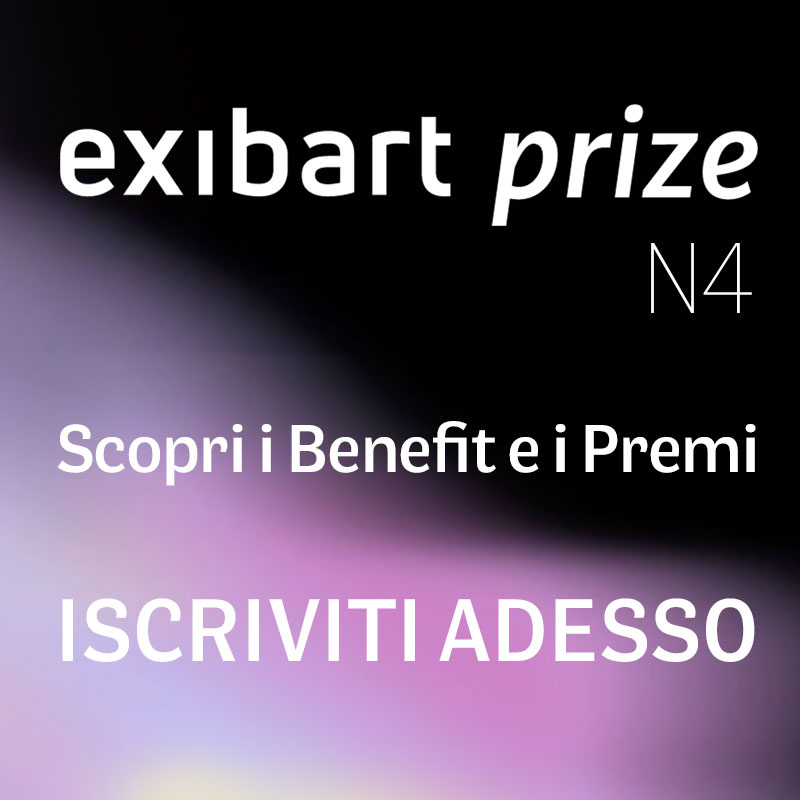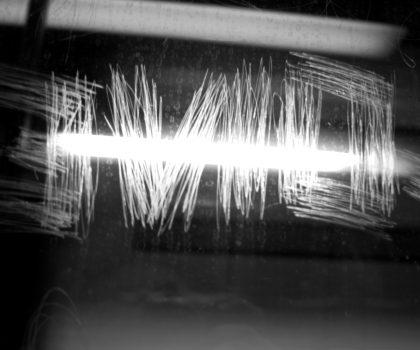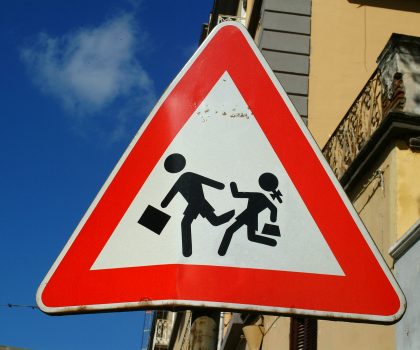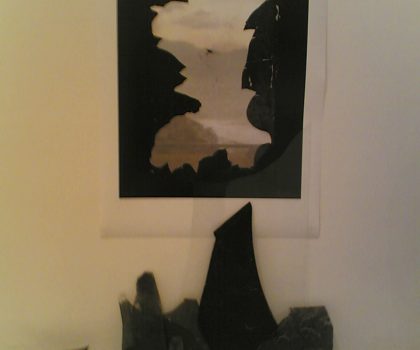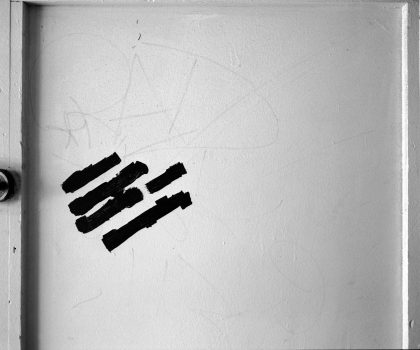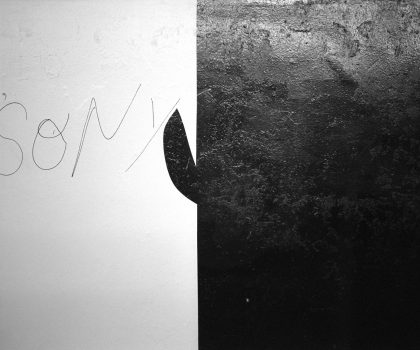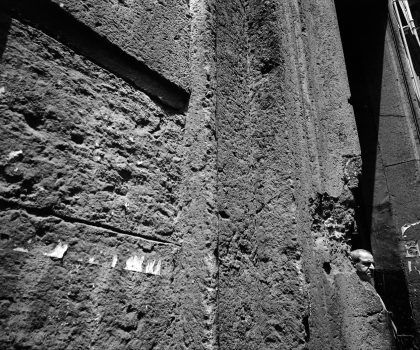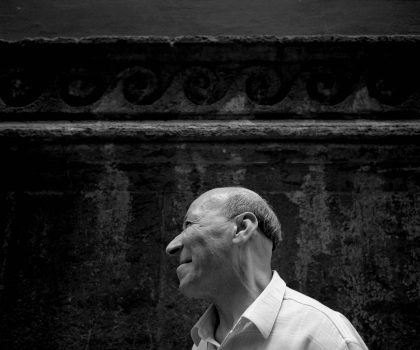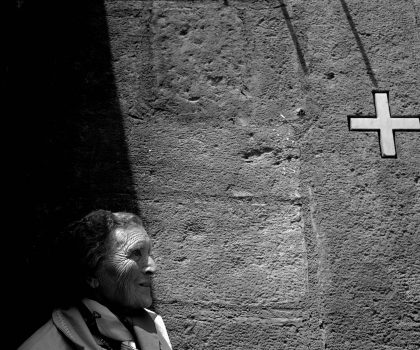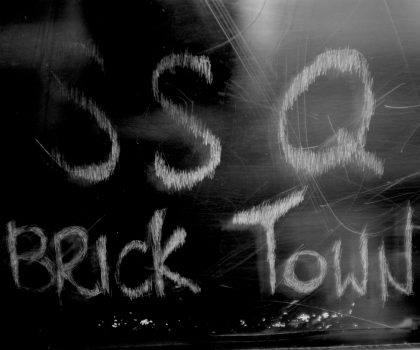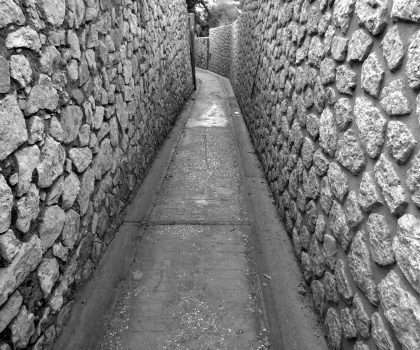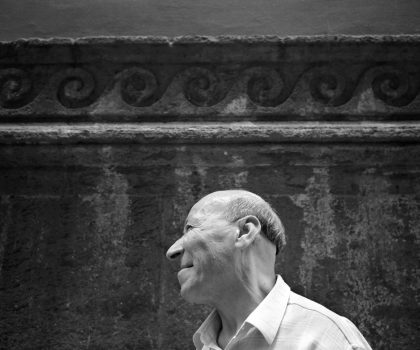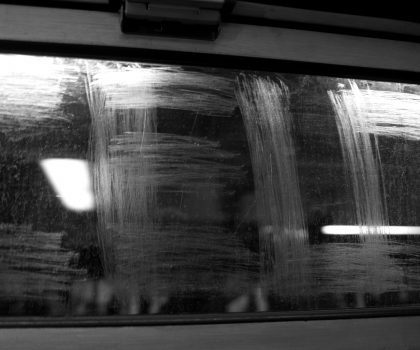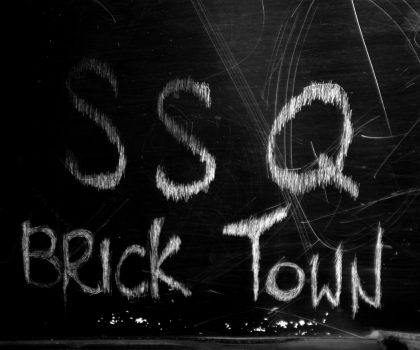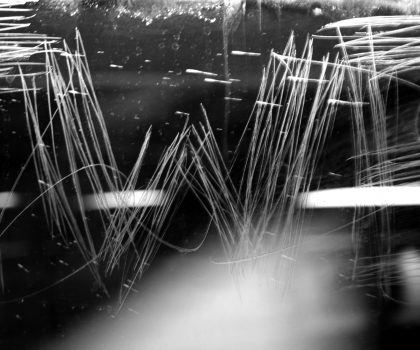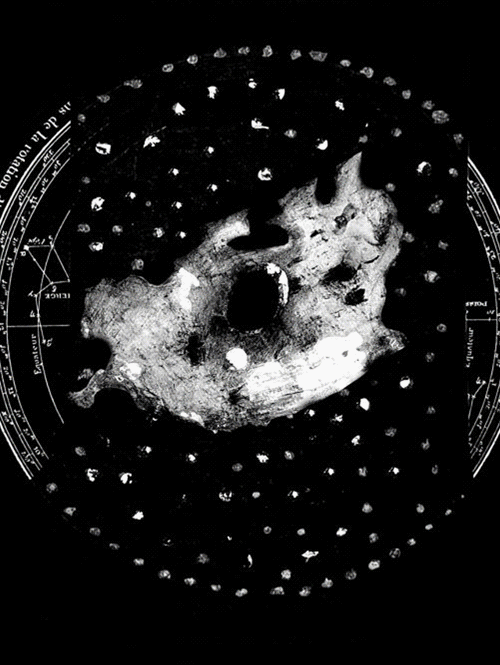SCRATCH
L'immagine presentata si impone con la sua energia brutale e incisiva, un'istantanea di un'azione sedimentata nel tempo, un gesto che si trasforma in memoria urbana. Il finestrino di un treno della metropolitana si trasfigura in un palinsesto visivo, in cui il "segno" - lo scratch profondo e deciso - diventa un codice linguistico della contemporaneità metropolitana. Un atto di appropriazione dello spazio pubblico, un graffio che grida presenza, esistenza, resistenza. L'intensità del bianco e nero enfatizza il contrasto tra il vetro intaccato e la luce che lo attraversa, restituendo un'immagine dal carattere quasi grafico, come se la metropoli stessa parlasse attraverso il gesto anonimo di chi ha inciso queste linee.
Immaginiamo ora altre trenta fotografie simili, una serie che costruisce un alfabeto visivo di questi tag urbani, uno dopo l’altro, a comporre un poema metropolitano inciso sulla pelle della città. Ogni finestrino è una tela, ogni incisione è una firma senza nome, un manifesto della contemporaneità, della ribellione sotterranea che pulsa sotto le strade di New York. Qui il graffito si smaterializza, diventa puro segno astratto, una traccia grafica che evoca la tradizione dell’Action Painting di Pollock o le sperimentazioni gestuali dell’Informale europeo. Ma, a differenza di queste esperienze pittoriche, il gesto non è più quello dell’artista in studio: è quello del graffittaro che lascia la sua impronta nel fluire caotico della metropoli, nella velocità delle carrozze della subway che trasportano storie, corpi, identità.
La modernità di questi scratch risiede nella loro essenza puramente segnica: l’assenza di colore e la reiterazione del tratto li rendono qualcosa di diverso rispetto al graffito tradizionale. Non c’è figurazione, non c’è lettering decorativo, non ci sono spray che esplodono in campiture cromatiche. Qui tutto è sintesi, è un codice ridotto all’osso, quasi un linguaggio segreto della strada, una scrittura asemica che trasforma la superficie liscia del vetro in un campo di battaglia visiva.
Nelle stazioni della metropolitana di New York, questi graffi si moltiplicano, creando un archivio di gesti spontanei, una mappatura della presenza umana. Ogni incisione è un’azione irreversibile, una sorta di ferita sulla pelle del mezzo pubblico, un’impronta del passaggio di un individuo che sceglie di lasciare un segno della propria esistenza. In un’epoca dominata dal digitale, dove le immagini si dissolvono in un flusso continuo e immateriale, questi scratch sono una forma di resistenza concreta, una scrittura incisa che non può essere cancellata con un click, un gesto primordiale che riafferma la fisicità del segno nell’era dell’effimero.
File digitale
Immaginiamo ora altre trenta fotografie simili, una serie che costruisce un alfabeto visivo di questi tag urbani, uno dopo l’altro, a comporre un poema metropolitano inciso sulla pelle della città. Ogni finestrino è una tela, ogni incisione è una firma senza nome, un manifesto della contemporaneità, della ribellione sotterranea che pulsa sotto le strade di New York. Qui il graffito si smaterializza, diventa puro segno astratto, una traccia grafica che evoca la tradizione dell’Action Painting di Pollock o le sperimentazioni gestuali dell’Informale europeo. Ma, a differenza di queste esperienze pittoriche, il gesto non è più quello dell’artista in studio: è quello del graffittaro che lascia la sua impronta nel fluire caotico della metropoli, nella velocità delle carrozze della subway che trasportano storie, corpi, identità.
La modernità di questi scratch risiede nella loro essenza puramente segnica: l’assenza di colore e la reiterazione del tratto li rendono qualcosa di diverso rispetto al graffito tradizionale. Non c’è figurazione, non c’è lettering decorativo, non ci sono spray che esplodono in campiture cromatiche. Qui tutto è sintesi, è un codice ridotto all’osso, quasi un linguaggio segreto della strada, una scrittura asemica che trasforma la superficie liscia del vetro in un campo di battaglia visiva.
Nelle stazioni della metropolitana di New York, questi graffi si moltiplicano, creando un archivio di gesti spontanei, una mappatura della presenza umana. Ogni incisione è un’azione irreversibile, una sorta di ferita sulla pelle del mezzo pubblico, un’impronta del passaggio di un individuo che sceglie di lasciare un segno della propria esistenza. In un’epoca dominata dal digitale, dove le immagini si dissolvono in un flusso continuo e immateriale, questi scratch sono una forma di resistenza concreta, una scrittura incisa che non può essere cancellata con un click, un gesto primordiale che riafferma la fisicità del segno nell’era dell’effimero.
File digitale
Salvatore Sparavigna, born in Naples, is a visual storyteller whose career spans over forty years of photojournalism, art, and civic engagement, weaving together narratives that fuse the rawness of reality with the poetry of imagery. A photographer, videomaker, journalist, and EU project designer, his work is a mosaic of cultural identities, social struggles, and artistic experimentation—rooted in Southern Italy yet reaching toward global horizons.
From Beginnings to Photojournalistic Excellence
His journey began in 1980 in the alleys of Naples, where, as a freelance photographer, he documented local news and social customs for regional publications. A major turning point came in 1986 with the founding of FO.R.N.ASS. (Photographers & Reporters of Naples Associated), the first photojournalism agency in Campania. This agency became a beacon for portraying Southern Italy beyond stereotypes. His images, published in L’Espresso and Il Venerdì di Repubblica, capture not only events but the very soul of the territory: from juvenile delinquency to the fight against the Camorra, every shot becomes a manifesto of truth. In the 1990s, his gaze expanded to Europe, working with international magazines and agencies. In 1997, he anticipated the digital revolution with Napoli Live Web News, one of Italy’s first multimedia news platforms.
Art as Protest, Identity as Mission
For Sparavigna, photography is not just a profession but a universal language. In his artistic projects, he bridges past and present: Carne di Piperno (1990–2005) overlays contemporary portraits with architectural remnants, creating a dialogue between eras. Meanwhile, Le pose del caffè a… (2003–2006, leposedelcaffe.org) transforms the espresso cup into a symbol of belonging, capturing subjects from Naples to New York in moments of intimate reflection. In 2007, at the invitation of the City of New York, he brought Faces of ItaliaNY to the U.S.—an exhibition celebrating Italian-American roots through faces and rituals, from Brooklyn’s processions to Manhattan’s elegant parlors.
Social Cinema and WebTV: Giving Voice to the Invisible
His civic commitment found expression in social cinema through documentaries that lay bare social wounds. A camorra… song io? (2009), premiered in Casal di Principe during the National Day of Remembrance for Mafia Victims, exposes the silent complicity of Neapolitan society. Le rughe del tempo (2014) blends archival footage and contemporary landscapes to revive collective memory. In 2010, he founded La mia strada TV, Southern Italy’s first webTV dedicated to marginalized communities: from reports on the homeless to live broadcasts from school workshops, he transforms digital media into an instrument of inclusion.
EU Project Design and Education: Building the Future
Alongside his artistic practice, Sparavigna cultivates a strategic vision. Since 2019, as a Social Change Manager and EU project designer, he has developed innovation pathways for Third Sector organizations, managing European funding and coordinating initiatives such as the New Agenda for the Mediterranean. In classrooms from Naples to Torre Annunziata, he teaches young people how to use cameras and social media as tools for awareness, leading projects like TV a colori (2019), where students become webTV creators. Recent certifications in Artificial Intelligence for the Third Sector (2024) and Tourism Management reflect an ever-curious and evolving intellect.
Exhibitions and Awards: The Legacy of a Visionary
His works have traveled from the PAN (Palazzo delle Arti Napoli) to the Italian American Museum in New York, and to international festivals. Exhibitions like Adolescence: What Future? (1996–2000), shown in Florence and Naples, or Emergency Room (2009), featuring burned windows symbolizing extortion, are silent cries against indifference. Among his accolades are the Golden Lion (2018) for social commitment and the Lifetime Achievement Award (2013) from the VerbinalandrArt Association—tributes to an artist who has turned photography into a political act.
Technique and Heart: The Duality of an Artist
A master of editing software and copyright law, Sparavigna handles both analog and digital languages with equal finesse. His images, often in black and white, play with dramatic contrasts and urban geometries, while his videos combine cinematic aesthetics with documentary rhythm. But humanity is the true common thread: behind every project lies a question, a challenge, an invitation to look beyond appearances.
Today, between consultancy work for Getty Images and multisensory exhibitions such as DECUMANI – Voices from the Heart of Naples (2017), Salvatore Sparavigna embodies the role of the engagé artist: a bridge between art and society, memory and innovation—proving that beauty can emerge from commitment.
From Beginnings to Photojournalistic Excellence
His journey began in 1980 in the alleys of Naples, where, as a freelance photographer, he documented local news and social customs for regional publications. A major turning point came in 1986 with the founding of FO.R.N.ASS. (Photographers & Reporters of Naples Associated), the first photojournalism agency in Campania. This agency became a beacon for portraying Southern Italy beyond stereotypes. His images, published in L’Espresso and Il Venerdì di Repubblica, capture not only events but the very soul of the territory: from juvenile delinquency to the fight against the Camorra, every shot becomes a manifesto of truth. In the 1990s, his gaze expanded to Europe, working with international magazines and agencies. In 1997, he anticipated the digital revolution with Napoli Live Web News, one of Italy’s first multimedia news platforms.
Art as Protest, Identity as Mission
For Sparavigna, photography is not just a profession but a universal language. In his artistic projects, he bridges past and present: Carne di Piperno (1990–2005) overlays contemporary portraits with architectural remnants, creating a dialogue between eras. Meanwhile, Le pose del caffè a… (2003–2006, leposedelcaffe.org) transforms the espresso cup into a symbol of belonging, capturing subjects from Naples to New York in moments of intimate reflection. In 2007, at the invitation of the City of New York, he brought Faces of ItaliaNY to the U.S.—an exhibition celebrating Italian-American roots through faces and rituals, from Brooklyn’s processions to Manhattan’s elegant parlors.
Social Cinema and WebTV: Giving Voice to the Invisible
His civic commitment found expression in social cinema through documentaries that lay bare social wounds. A camorra… song io? (2009), premiered in Casal di Principe during the National Day of Remembrance for Mafia Victims, exposes the silent complicity of Neapolitan society. Le rughe del tempo (2014) blends archival footage and contemporary landscapes to revive collective memory. In 2010, he founded La mia strada TV, Southern Italy’s first webTV dedicated to marginalized communities: from reports on the homeless to live broadcasts from school workshops, he transforms digital media into an instrument of inclusion.
EU Project Design and Education: Building the Future
Alongside his artistic practice, Sparavigna cultivates a strategic vision. Since 2019, as a Social Change Manager and EU project designer, he has developed innovation pathways for Third Sector organizations, managing European funding and coordinating initiatives such as the New Agenda for the Mediterranean. In classrooms from Naples to Torre Annunziata, he teaches young people how to use cameras and social media as tools for awareness, leading projects like TV a colori (2019), where students become webTV creators. Recent certifications in Artificial Intelligence for the Third Sector (2024) and Tourism Management reflect an ever-curious and evolving intellect.
Exhibitions and Awards: The Legacy of a Visionary
His works have traveled from the PAN (Palazzo delle Arti Napoli) to the Italian American Museum in New York, and to international festivals. Exhibitions like Adolescence: What Future? (1996–2000), shown in Florence and Naples, or Emergency Room (2009), featuring burned windows symbolizing extortion, are silent cries against indifference. Among his accolades are the Golden Lion (2018) for social commitment and the Lifetime Achievement Award (2013) from the VerbinalandrArt Association—tributes to an artist who has turned photography into a political act.
Technique and Heart: The Duality of an Artist
A master of editing software and copyright law, Sparavigna handles both analog and digital languages with equal finesse. His images, often in black and white, play with dramatic contrasts and urban geometries, while his videos combine cinematic aesthetics with documentary rhythm. But humanity is the true common thread: behind every project lies a question, a challenge, an invitation to look beyond appearances.
Today, between consultancy work for Getty Images and multisensory exhibitions such as DECUMANI – Voices from the Heart of Naples (2017), Salvatore Sparavigna embodies the role of the engagé artist: a bridge between art and society, memory and innovation—proving that beauty can emerge from commitment.

